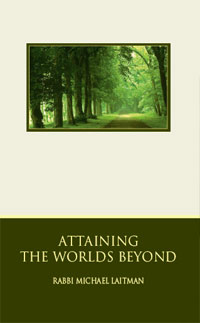Four Fundamental Outlooks on the Soul
Because we lack concrete information about the structure and function of higher, elusive notions we cannot feel, we permit ourselves to philosophize and argue about how they might be constructed and how they might function. This is similar to children’s arguments over who is right about some completely unknown subject.
When religious, secular, scientific and pseudoscientific philosophies try to define “soul” and “body,” they all focus on four fundamental outlooks:
Outlook #1: Religious
All that “exists” in any object is its “soul.” Each soul differs from another by its qualities, known as the “spiritual qualities” of a person. Souls exist independently of the body before the body’s birth, before being garbed in the body, and after the body’s death. The latter is a completely biological process of albumen breaking down into its parts. (The notion of a “believer” is not the same as the notion of one who is “religious”).
Thus, the death of the physical body does not affect the soul itself, but only serves to separate the soul from the body.
The soul represents something eternal, since it is not composed of materials from this world. By its nature, the soul is undivided. It does not consist of several parts, and therefore cannot be divided, cannot disintegrate and, ultimately, cannot die.
The physical, biological body is the outer “clothing” of the soul. It is the garment in which the soul dresses and, acting through the body, displays its intellectual and spiritual qualities, as well as its character. This can be compared to when we drive a car, displaying our own wishes, character and intellect in the way we operate the car.
In addition, the soul gives the body life and motion, and protects the body to such an extent that, without the soul, the body lacks life and movement. The body itself is dead material, just as it appears to us after the soul leaves it at the moment of death.
We call the moment of death “the departure of the soul from the body.” As a result, all signs of life depend on and are determined by the presence of the soul.
Outlook #2: Dualistic
As a result of scientific developments, a new outlook on the physical body has emerged: the belief that our bodies can also exist without any kind of spiritual component to invigorate them.
In fact, the body can exist absolutely independently of the soul. This has been proven with the use of biological and medical experiments that are now able to revive the body or its parts.
But the body in a state like this is no more than an independently existing biological object, composed of albumen substances. The factor that determines various personal qualities is the soul, which descends into the body from Above, as in the first approach. The difference between the Dualistic approach and the Religious point of view centers on the fact that the Religious approach proposes that, just as the soul endows the body with life, it also bestows upon it intellectual and spiritual qualities.
The Dualistic point of view argues that the soul bestows only spiritual qualities on the body, since it is evident from experiments that the body can exist by itself, without the help of any additional upper powers. Thus, the soul’s only function is to be the source of all of the good qualities that are “spiritual,” but not material.
Moreover, this approach maintains that, despite the body’s ability to exist independently, it is nevertheless the product of the soul. The soul is seen as primary, since it is responsible for the birth and maintenance of the body.
Outlook #3: Non-Believer
A non-believer is one who denies the existence of any spiritual structures, as well as the presence of the soul in the body. The non-believer only recognizes the existence of material substances and their properties.
Thus, it is reasoned, since there is no soul, the human intellect, as well as all other properties of the human being, is the result of the body that generated it. The view is that the body is a system that controls its characteristics by sending commands through electrical signals via nerve conductors. (A non-believer is not the same thing as non-religious).
Non-believers say that all the sensations of the body occur by the interaction of nerve endings equipped with outer stimulators. The sensations pass via the nerve conductors to the brain, where they are then analyzed and classified as either “pain” or “pleasure.”
The mind reacts to a particular organ in response to whether it perceives it as painful or pleasurable. In addition, it is believed that everything is constructed as in a mechanism with sensors, whereby signals are transmitted to, processed and emitted by the brain device.
They are also controlled by means of reverse feedback. The brain operates according to the principle of distancing itself from pain, and coming closer to pleasure. The pain vs. pleasure signals will determine the person’s attitude towards life, and one’s consequent actions.
We perceive reason as a reflection of our physical processes, similar to a photograph. The main difference between a human being and an animal is the fact that the human brain is so well developed. In fact, all the processes taking place in human beings are condensed into such an exhaustive picture that we perceive these processes as reason and logic. But our entire intellect is the result of our physical perceptions and awareness.
This concept presents human beings as robots in the hands of blind nature (predetermined qualities of character, laws of social evolution, demands of our bodies to sustain life and search for pleasure, etc). All these deprive us of the status of reasoning beings.
Thus, if a human being is merely a mechanism, forced to act in accordance with data initially prepared in it, and with the accepted norms of society, then this theory negates the whole idea of free will and the right to choose our actions (objective thinking).
Outlook #4: Modern
This has become fashionable, especially today (despite our tendency to accept the previous, materialistic approach to creation as the most scientifically reliable and understandable). It is also fashionable to concede that something eternal, undying and spiritual in us exists that drapes itself in the material bodily casing. Specifically, this is our spiritual essence, known as the soul, whereas the body is only the garb.
Still, the adherents to this view cannot explain how the soul becomes clothed by the body, the relationship between soul and body, the source of the soul, and the essence of the soul. Thus, closing their eyes to all these questions, human beings resort to an old, tested method of complacency: they forget about all their concerns in the torrent of daily petty burdens and delights, living today just as they did yesterday.
The Need for a True Perception
Who can understand such questions as: What is the body and what is the soul? What is the relation between them? Why do we perceive ourselves as being comprised of two parts, the material and the spiritual? In which of these two can we find ourselves, our eternal “I?” What happens to our “I” before our birth and after our death? Does it remain the same “I” as we perceive now? Is it the same as the one felt within our body and outside of it, before birth and after death?
Most important, we use our physical intellect to analyze all these questions and possible alternatives. This is how we assess how our souls are transformed and circulated, and how our bodies became material.
The mind can operate only on the basis of how it perceives the world imprinted in it, and thus produces our fantasies and assumptions.
We are then faced with the question, “What if all that we are able to imagine, which is the basis of our theories of life, is nothing more than our minds’ attempt to grasp something beyond our capacity to grasp?
Given the four categories of how we understand an object—its material composition; its outer form; its abstract form, and its essence—we can only perceive the outer form of the object as it appears to us and, after examining it, the material of which it consists. But we have no understanding of the removed form of the object, that is, its non-material qualities (its essence).
In order to acquire a true perception, such deep understanding, attainment we need the Wisdom of Kabbalah.
 “Humanity’s 4 Outlooks on the Soul” is based on the book, Attaining the Worlds Beyond by Dr. Michael Laitman.
“Humanity’s 4 Outlooks on the Soul” is based on the book, Attaining the Worlds Beyond by Dr. Michael Laitman.

